Instead of screaming into the void of Twitter, I bring you a weekly highlight reel of what it’s like going places in Greater Hartford when one is gloriously car-free. These posts are on a slight time delay because nobody needs to know exactly where I am when I am there.
BC54600
That’s the plate of the vehicle driven through the Asylum and Sigourney intersection when all vehicle lights were red and the pedestrian phase had begun. It was as if I weren’t even in the roadway. It was like I hadn’t patiently stood on the corner turning into a popsicle while I waited too long to get that pedestrian light. It was like my life didn’t matter even a tiny bit to someone who was in a huge rush to . . . wait. Yes, wait. After that illegal and dangerous maneuver, the driver pulled over to the side of the road, just a few feet after the intersection, and was waiting, presumably for someone they were picking up. I didn’t stay around to see, and it took every ounce of self control to only snap the photo of the offending person’s vehicle rather than rap on their window and give them an earful.
Earlier in the day, I’m at another corner, waiting and waiting for my turn. When that pedestrian light comes on, I begin to cross. All other vehicle lanes have the red light. A driver begins to make a right turn and then realizing he can’t drive through me, chooses to gun it straight through the intersection. Again, every other light was red. This meant he went speeding through a construction zone.
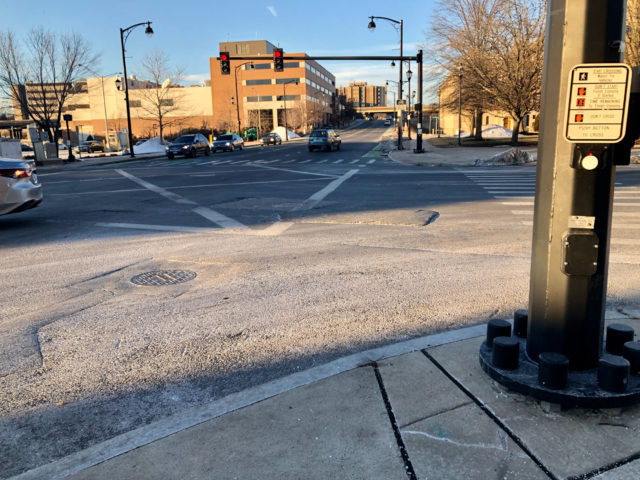
A few days later, I’m at one of my least favorite Hartford intersections: Broad and Capitol. That’s it, above. It was worsened a few years ago. Widened. How do you want to ensure recklessness? Widen an already wide intersection that is one block from a highway entrance. There is something that happens in drivers’ brains near highway ramps. It seems like what happens when kids go into candy stores. They can only think about one thing.
So, I’m standing there at the edge of the concrete slab park built over the Park River, waiting for my turn. All vehicle lights go red. I check and then begin to cross. Midway through the lane, not one, not two, but three drivers blow a LEFT through the red light, turning from Capitol Avenue onto Broad Street . . . toward the highway. One was trying to pass another while making the turn. Then two of them have the nerve to start honking at me, as if I being exactly where I was entitled to be was inconveniencing them.
Choosing to not throw rocks at their cars today, I slowed my pace down. Way down. I motioned to the crosswalk. I gave them the hand. I made them wait.
There are those who oppose red light cameras because they see these as unfairly punishing the poor or “unfairly punishing the poor.” But where are they when it comes to how the poor are usually the ones getting killed as pedestrians? Nowhere. And this isn’t an invite for people to make their case about red light cameras. It’s an invite, a challenge, a dare for those who have been opposing them to step up and take real action toward improving our infrastructure. If we can’t/won’t fund projects that narrow intersections, if we can’t/won’t fund barrier protected bike lanes, then accept that punitive measures will have to be the way to go, at least until we see the political will to do better. And if we’re talking punitive measures, it’s gotta be red light cameras all the way because, among the million other reasons, as we keep hearing, police can decide not to do their jobs when they’re feeling sad. Sorry, my bad, “demoralized.”
Our roads are a problem.
There were eight pedestrian deaths in the state last month; a 15-year old girl was killed in the roadway near her high school in February.
In several cases, without knowing anything else, it was easy to see how road design and road accessories contributed to their deaths: no sidewalks, no crosswalks, no lighting, stroads. In two of these deaths, pedestrian infrastructure had not been properly cleared of snow.
But as I keep getting reminded, when a person outside of a vehicle is hit by someone inside of one, we are likely to see in a crash report how the victim was not using the space properly. There is no footnote that explains this was because the dominant culture has made it next to impossible for pedestrians to properly use the space.
If you want to talk about equity issues, this is precisely where to start: make it so a 15-year old child can safely, conveniently, and independently get home from school.
Can someone in a wheelchair use the sidewalk after a snowstorm, or does she have to wait an entire week for the snow to melt?
In 2021, at least 57 pedestrians and cyclists were killed by drivers in Connecticut.
That phrase “at least” gets used because I can’t say with certainty.
In late January, I was still finding data added to the crash data repository from the previous year; this data reflected people killed whose deaths had not been reported on in the media, even though the victims died from their injuries either immediately or within a few days of the collision.
Humans created these problems. We can solve them. It’s a matter of having the will to do so. Nobody’s hands are tied, and any public servant who claims such should be fired immediately.
PANDEMIC BUS
In my N95
roasting and resentful
three passengers
masks drooping under chins
blowing their noses.
I think about the marshmallow test.
LET’S PARTY
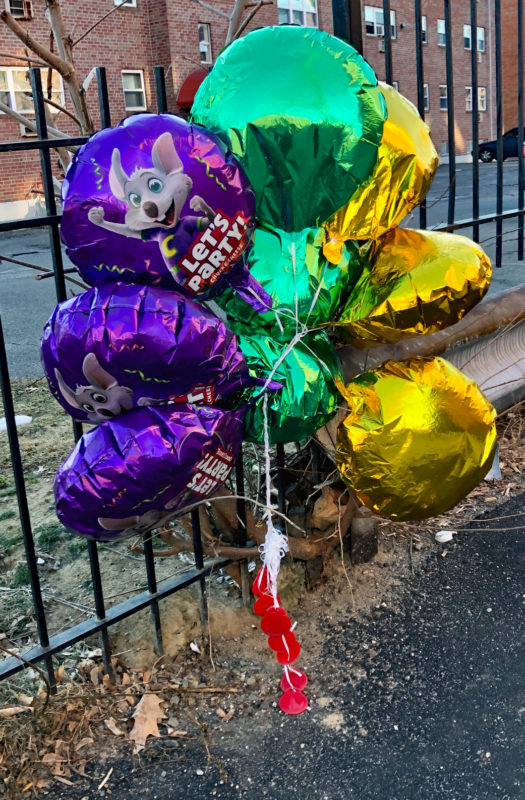
Wayward Mardi Gras balloon cluster? A driveway shrine? Frivolous waste and environmental hazard? All or none of the above? I walk by it day after day, wondering when it will be removed. Do we abandon what ceases to be shiny?
ODE TO AN ABANDONED BICYCLE
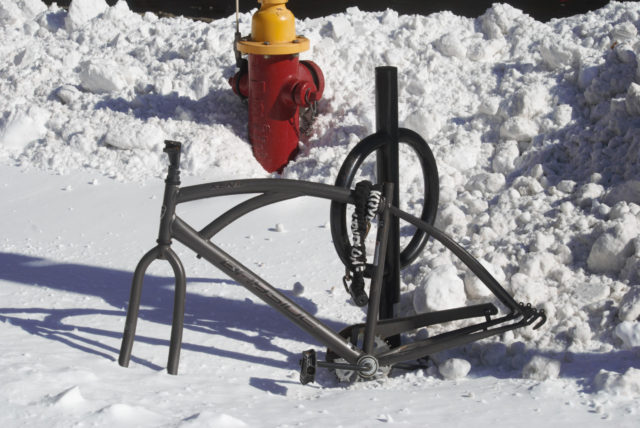 You tried to hold
You tried to hold
on tightly, with a lock
— kryptonite —
which harms the hero,
not the villain, if you recall.
This bicycle is an abandonment issue.
PARK RIVER VIEW
Can you see animal tracks on the frozen river from inside a car? Doubtful.
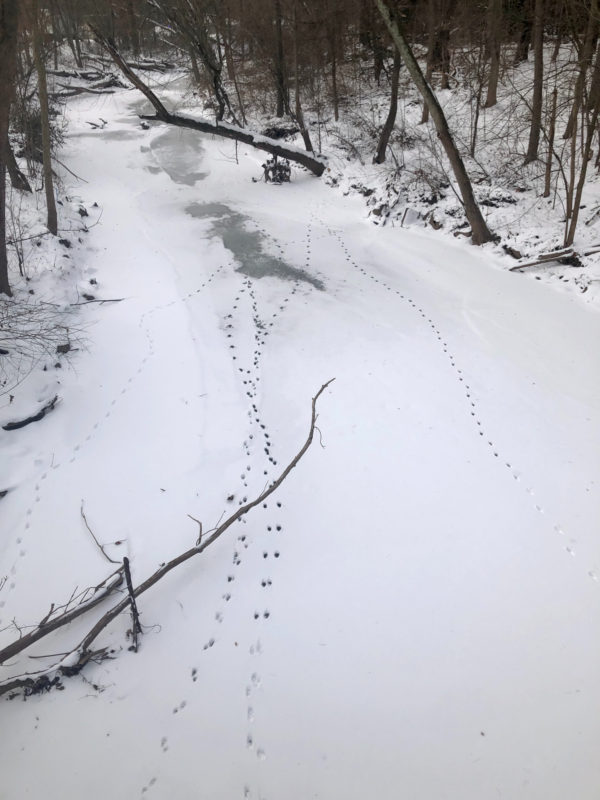
CALM LIKE A BOMB CYCLONE
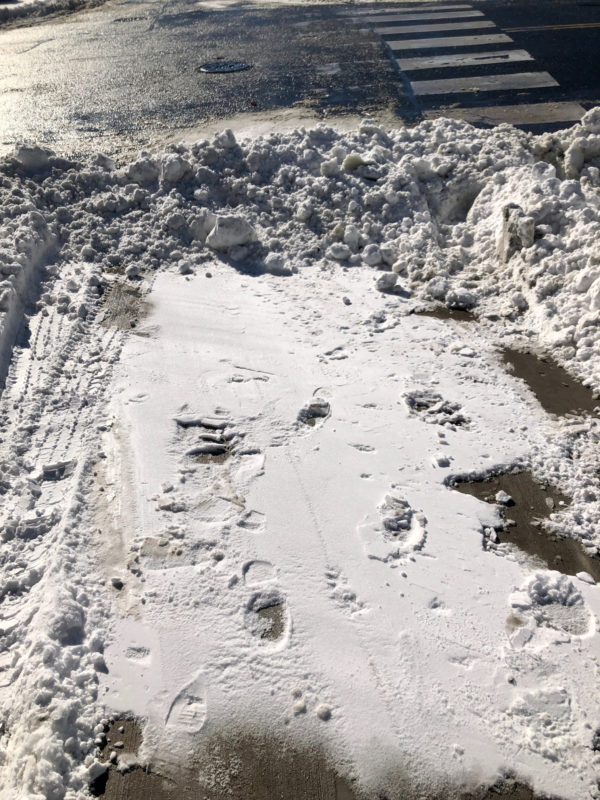
It’s cool. Scaling a snow mound to enter or exit the park is fine. Do those with the plows envision people merely walking circles inside of parks, with no place else to go?
Contrast that with this stellar clearing job on Park Street. Same day, about 10-15 minutes before the Bushnell Park photo was taken. Props to whoever is doing the maintenance for Park Hardware and the Main Street Pharmacy. Most of Park Street did not look this good.
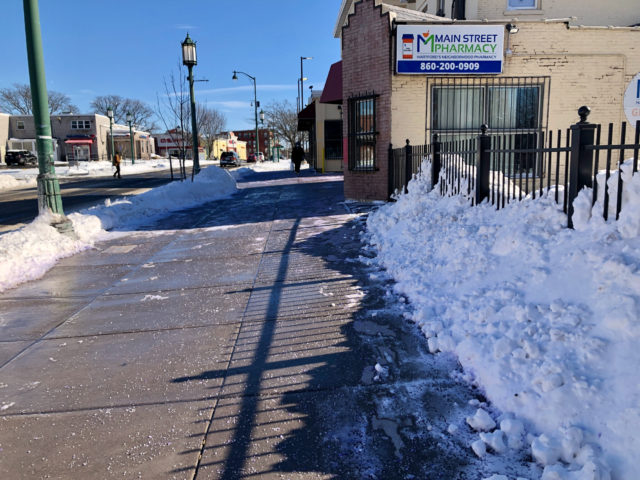
Here’s the thing. When people are not provided with safe places to walk, some will go with the option that seems better. In the case shown below — Niles Street, a couple blocks from the middle school — a person is walking on the clear and dry street because look at the alternative.
This is painful to watch, knowing that when a driver hits someone walking in the street, it’s the pedestrian who will get the ticket (if not killed) and they will be deemed to have been using the roadway improperly. Will the property owner be fined for creating that situation through neglect? Doubtful.
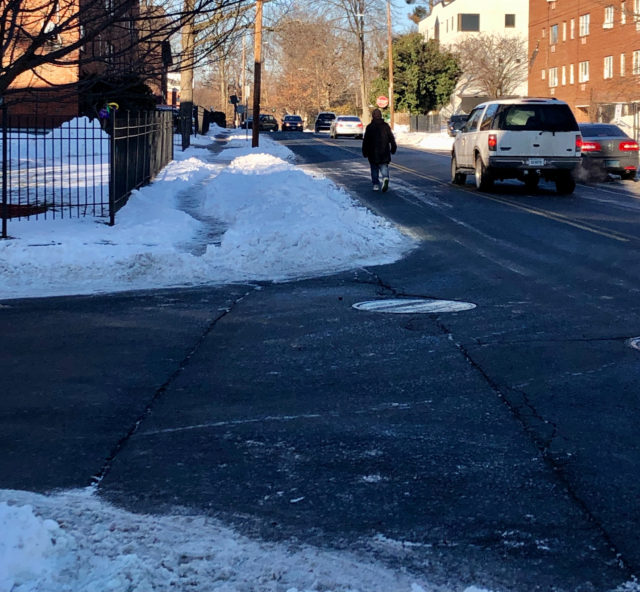
It’s usually the same properties each year, and before anyone cries about someone’s personal circumstances, most of these are LLCs, City or State property, or an organization.
The chronic offender below is the neglect of 785 Asylum Avenue. This has happened in past seasons, too. What you are looking at is uncleared snow 72 hours after storm ended. Not even a tiny path was cleared. This blocks the crosswalk. This blocks the bus stop. The options are to walk in Asylum Avenue or use the icy stomped in path. Or walk on (frozen) water.
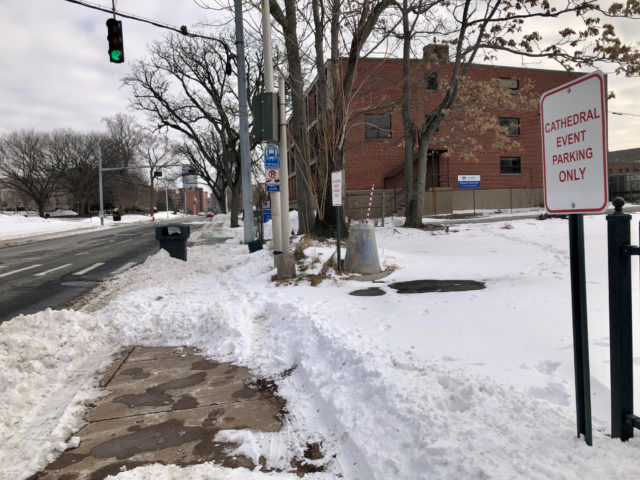
Below, the work of another chronic offender: the Family Dollar plaza at Farmington and Sigourney. Why do you hate your customers? Why do you hate your neighbors? They will plow to the pavement their front and underused back lot, but neglect the sidewalk.
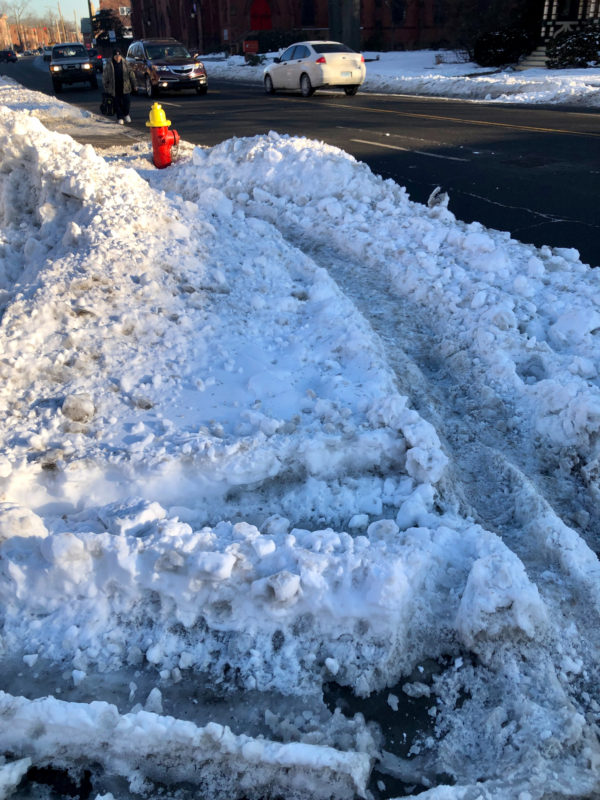
And I have a real problem with that because when you don’t clear the path, people struggle.
Below? That’s someone pushing a stroller, followed by two young children who were slipping and sliding around in that tiny path.
Can someone using a stroller or a wheelchair easily use the sidewalk? No? Then you failed. This photo was taken 72 hours after the storm ended. There is zero excuse for this.
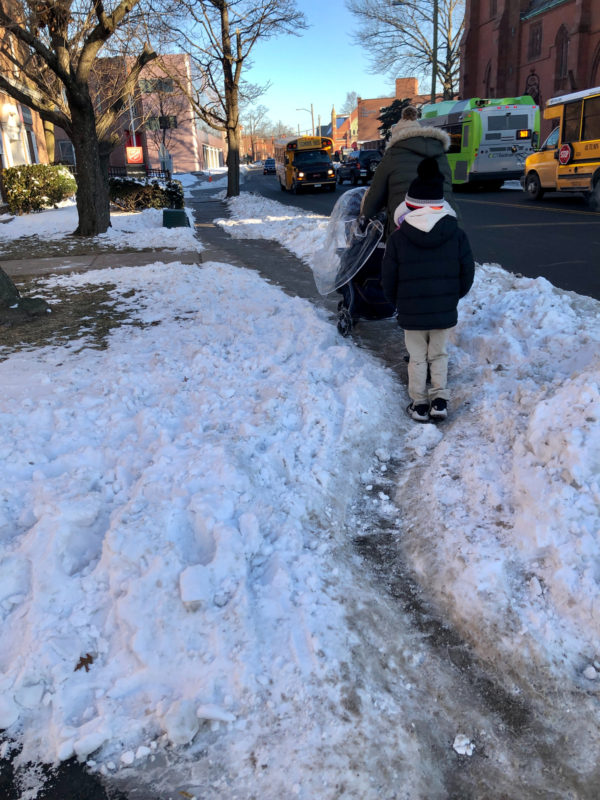
Below: 527 Farmington Avenue, 96 hours after storm ended:
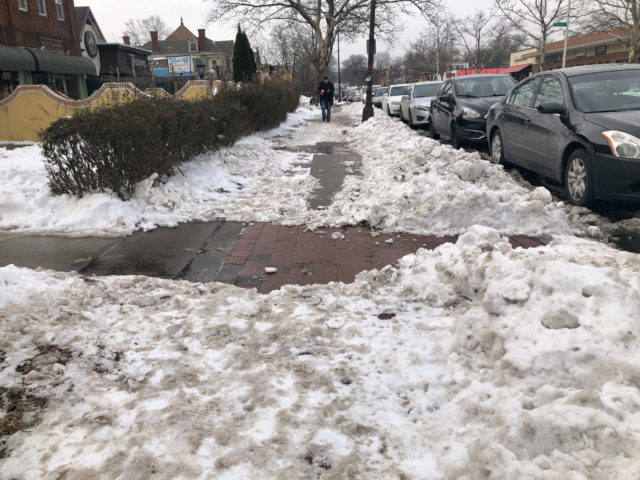
Below, this is what was deemed acceptable 72 hours after the storm at 887 Asylum Avenue. Why do you hate your tenants?
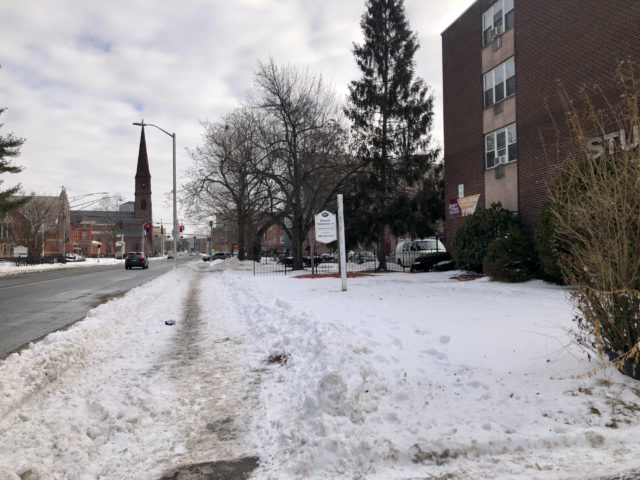
Like many other parking lots in Hartford, the one associated with this sidewalk has been empty during the pandemic. Its owner decided in the previous storm and this recent one at the end of January to just neglect maintenance. I mean, who’s going to enforce anything? The City of Hartford? This is 255 Putnam Street.
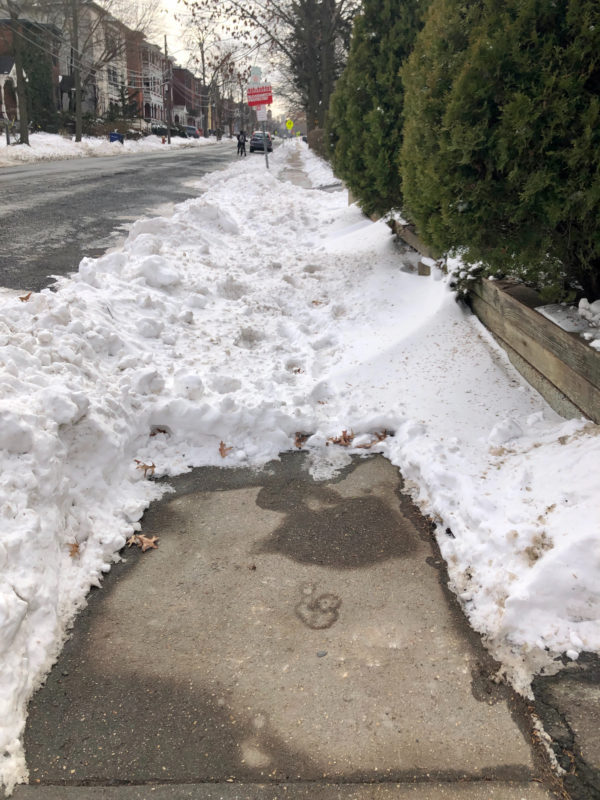
I have to wonder if neighborhood groups, like the Asylum Hill Neighborhood Association and West End Civic Association, are doing anything to address this. Besides the law, besides access, besides human decency, it’s a bad look to have Farmington Avenue — the business district in the West End — be a disaster for pedestrians days after a storm.
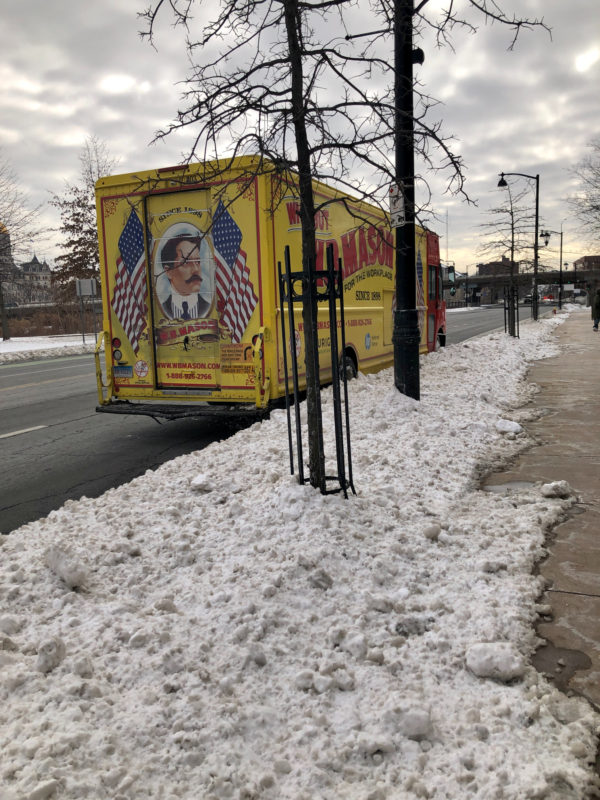
“BIKE LANE” QUIZ
In which of Hartford’s bike lanes is this truck illegally parked?
A) Broad Street
B) Could be any of them
C) Hartford, where we arrest people for panhandling but where businesses can basically do whatevs?
D) The only bike lane in Hartford is on Wethersfield Avenue. Everything else is just performative striping.
Though the green painted lane on Broad Street had been (mostly) cleared of snow, it still doesn’t function as a bicycle lane because vehicles are able to drive right into it. What’s obnoxious about the delivery truck situation in Hartford is just that: this is Hartford. It’s not Manhattan. Not Brooklyn. There are parking lots everywhere. Where he was delivering had a surface lot with ample parking, but casually endangering another road user was more convenient for him. I’m sure there are shitty company policies that pressure delivery drivers to park illegally. It happens too frequently to pin it on drivers making bad choices independently.
This same action has been seen in every bike lane or “bike lane” that Hartford has striped.
Another argument for adding barriers to divide these lanes from car lanes is something I witnessed walking along Farmington Avenue, 96 hours after the bomb cyclone ended. Many of the properties — in both the West End and Asylum Hill — never bothered to clear the sidewalk. I watched as a man decided he’d had enough of that, and opted to walk in the bike lane instead. The substandard Farmington Avenue bicycle lane was mostly cleared, and I saw how he stayed in it for two neighborhoods. I slipped around on the unplowed sidewalk, hoping for the best for us both, holding my breath as I saw vehicles being driven closely by him. People make shitty choices when given shitty options. Bike lanes should be only where people ride bicycles, and not where they walk, but I have to wonder if this is a reasonable solution. If Hartford wants to keep throwing money at a bloated police department while skimping on other city services, perhaps installing bollards that require less in the long run than making phone calls or visits to neglectful property owners who won’t clear their sidewalks. . .maybe that’s the direction we go in.
Except will the DPW plow those protected bike lanes, or will we hear excuses for why this is unpossible?
QUESTION EVERYTHING
Six trips before noon. That’s how many times a plow truck cleared my street. One would have sufficed for time being, with a follow up much later and then clearing the parking lane. The problem is that the street, once a two-way, was converted to one-way, without narrowing. Is this better or worse than that time we didn’t see a single plow truck for days during that storm when Hartford rented that ice dragon machine from Canada?
Something I have begun to question is the insistence that we not shovel snow into the roadway. That’s public space.
Storage of private property in the street: a drawing by @davewalker pic.twitter.com/kVnMaLln79
— Jon Owen (@anotherJon) February 3, 2022
Nature is a better use for the street than someone idling in front of my house. Almost every single street in Hartford should be narrowed for safety’s sake. It would be expensive to actually do this, but we could for part of a season let nature do the work for us. There are a few exceptions, but perhaps instead of issuing a blanket scolding of residents moving snow from sidewalks and driveways into the streets, we could simply say which specific streets can’t afford to be narrowed more? Someone on the City payroll could do the legwork, but off the top of my head I’m thinking the exceptions to the current rule would be Congress Street and Mannz Street, along with any road that has a marked bike lane. (Though the remainder of the street can probably stand to be narrowed, design is such that people would be dropping snow in the bike lanes themselves, defying the purpose of a separate area for cyclists; however, if they were willing to make a giant snow wall between the car lane and bike lane, it’d be a totally different story) If an emergency vehicle can fit down the street, that should be good enough. Why do we think people need to be able to go 35 MPH at all times in residential areas?
The thing is, “curb-to-curb plowing” is one of these mindless low-level things, much like filling potholes, that can be done to win political favor, even though having partially cleared roads and some obstacles could potentially improve safety. It’s like when people were freaking out because Woodland Street had gone without striping for awhile after the repaving last year. Making drivers have to think about and negotiate movement in their environment is not a bad thing! Why do we treat it as such? Aside from when some genius decided we needed to make people walk in one-way patterns in grocery stores and other public places (because they didn’t know how viruses worked) you don’t see this system enacted elsewhere. I can walk down a sidewalk and figure out how to share that space with people walking the other way. I’m searching my memory hard to think of the last time I so much as lightly bumped into a stranger while walking, and it’s been at least several years and possibly not even in Hartford. If I had to place money on it, this would’ve been in Times Square.
This isn’t an argument against striping the roads – it’s just, well, it’s worth thinking about the practices we accept as normal without question. And I am absolutely questioning the value of spending tax money to clear extra lanes on streets that should be narrowed.
WHAT NEXT
- Download the Bike Lane Uprising mobile app or use their website to submit bike lane obstructions in your city. Next time someone suggests it’s not a big deal for them to block a lane, point them to the database that shows how pervasive this is, especially for faux bike lanes that lack barriers.
- Join the New Haven Coalition for Active Transportation (NHCAT) and New Haven Bike Month to help plan celebrations of biking and walking for May. Register here for the virtual meeting on February 23, 2022.




















